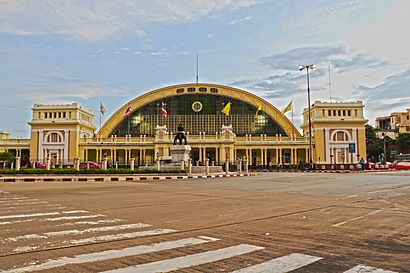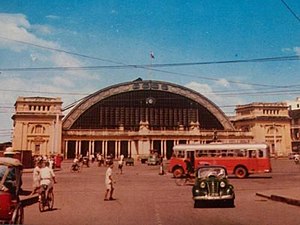Bangkok railway station
Bangkok กรุงเทพ | |||||||||||||||||||||||
|---|---|---|---|---|---|---|---|---|---|---|---|---|---|---|---|---|---|---|---|---|---|---|---|
 | |||||||||||||||||||||||
| General information | |||||||||||||||||||||||
| Other names | Hua Lamphong สถานีหัวลำโพง | ||||||||||||||||||||||
| Location | Rama IV Rd, Rong Mueang, Pathum Wan Bangkok Thailand | ||||||||||||||||||||||
| Coordinates | 13°44′20″N 100°31′0″E / 13.73889°N 100.51667°ECoordinates: 13°44′20″N 100°31′0″E / 13.73889°N 100.51667°E | ||||||||||||||||||||||
| Owned by | State Railway of Thailand | ||||||||||||||||||||||
| Platforms | 14 | ||||||||||||||||||||||
| Tracks | 14 | ||||||||||||||||||||||
| Connections | Bangkok MRT at Hua Lamphong BMTA Bus | ||||||||||||||||||||||
| Construction | |||||||||||||||||||||||
| Disabled access | Yes | ||||||||||||||||||||||
| Other information | |||||||||||||||||||||||
| Status | Preparated closure[1] | ||||||||||||||||||||||
| Station code | กท. | ||||||||||||||||||||||
| History | |||||||||||||||||||||||
| Opened | 25 June 1916 | ||||||||||||||||||||||
| Electrified | No | ||||||||||||||||||||||
| Passengers | |||||||||||||||||||||||
| 60,000+ per day | |||||||||||||||||||||||
| Services | |||||||||||||||||||||||
| |||||||||||||||||||||||
| Location | |||||||||||||||||||||||
 | |||||||||||||||||||||||
Bangkok railway station (Thai: สถานีรถไฟกรุงเทพ), unofficially known as Hua Lamphong station (Thai: สถานีหัวลำโพง), is the central station in Bangkok, Thailand. It is in the center of the city in the Pathum Wan district, and is operated by the State Railway of Thailand (SRT).
Naming
The station is officially referred to by the State Railway of Thailand as Sathani Rotfai Krung Thep (สถานีรถไฟกรุงเทพ) in Thai (Krung Thep is the transliteration of the common Thai language name of Bangkok),'Bangkok Station' in English.[2] Hua Lamphong (Thai: หัวลำโพง) is the informal name of the station, used by locals, tourist guides and the public press.[3] In outlying areas of Thailand the station is commonly referred to as Krungthep Station, and the name Hua Lamphong is not well-known. In all documents published by the State Railway of Thailand (such as train tickets, timetables, and tour pamphlets) the station is uniformly transcribed as Krungthep (กรุงเทพ) in Thai.[2]
The name Hua Lamphong is the name of both a canal and a road (now Rama IV Road) that used to pass near this station. The name Hua Lamphong, some say originated from the green plains surrounding the area in the past that were used to graze the cattle of the Muslim community, when the people saw the cattle running vigorously in the plains, it was named the Thung Wua Lamphong ('swaggering bulls plains'), eventually being called Hua Lamphong.[4] Others presumed that the name originated from a species of plant called Lamphong (Datura metel), a toxic plant that used to grow abundantly in the area.[5]
It is also thought that the name may have a Malay origin as a mixture of khua in Thai, meaning 'bridge', and the word lampung in Malay (pronounced lumpung) meaning 'to float'. Loi Khua Lumphung, thus meaning a temporary bridge (across or floating on the river) then become known as Hua Lamphong by Thais.[6]
Hua Lamphong railway station actually was a name of another railway station of private Paknam Railway Line which operated before the founding of the Royal Siamese Railway Department (now the State Railway of Thailand). Hua Lamphong railway station was opposite the present day Bangkok railway station. It opened in 1893 and closed in 1960 in conjunction with the dissolution of the Paknam Railway Line. The site of the demolished Hua Lamphong railway station borders Rama IV Road. Today, the Bangkok subway's Hua Lamphong MRT station lies beneath it.[7]
History
The station was opened on 25 June 1916 after six years of construction that started in 1910 in the reign of King Chulalongkorn and finished in the reign of King Vajiravudh.[4] The site of the railway station was previously occupied by the national railway's maintenance centre, which moved to Makkasan in June 1910. At the nearby site of the previous railway station a pillar commemorates the inauguration of the Thai railway network in 1897.
The station was built in an Italian Neo-Renaissance-style,[4] with decorated wooden roofs and stained glass windows, with the Frankfurt (Main) Hauptbahnhof in Germany as a prototype.[4] The front of the building was designed by Turin-born Mario Tamagno,[4][8] who with countryman Annibale Rigotti (1870–1968) was also responsible for the design of several other early 20th century public buildings in Bangkok. The pair designed Bang Khun Phrom Palace (1906), Ananta Samakhom Throne Hall in the Royal Plaza (1907–1915)[4] and Suan Kularb Residential Hall and Throne Hall in Dusit Garden, among other buildings.
Initially, Hua Lamphong was a combined railway station: it transported goods and people. Over time, the transport of freight and passengers proved untenable due to the limited area for expansion of the 120 rais (48 acres) site. The transport of goods was shifted to the Phahonyothin freight yard in 1960.[9]
The station is an air-conditioned two-storey building consisting of two main entrances, 12 platforms, 22 ticket counters, and two electric display boards, with one mega television screen. Above two entrances to the platforms are the large pictures showing the beginning of the Thai railway history. In the booming railway travel era, a right part of the station building used to be 10-rooms for who wants to stay overnight in the form of transit hotel named "Rajdhani Hotel" (โรงแรมราชธานี), it was in operation between 1927 and 1969.[7]
On 8 November 1986, 6 runaway, unmanned, coupled locomotives which had their engines left on due to maintenance works at Bang Sue Depot collided at Bangkok railway station, killing 4 and injuring 4.[10]
Prior to 2020, Hua Lamphong served about 200 trains and approximately 60,000 passengers each day.[4] Since 2004 the station has been connected by an underground passage to the MRT (Metropolitan Rapid Transit) subway system's Hua Lamphong MRT Station. The station is also a terminus of the Eastern and Oriental Express luxury trains,[11] and the International Express to Malaysia.[12]
On 25 June 2019, the 103rd anniversary of Hua Lamphong was celebrated with a Google Doodle.[13]
Closure

The station was scheduled to be closed as a railway station in 2021, when it would have been converted into a museum. The station will change its official name to Hua Lamphong Station. The State Railway of Thailand will move Bangkok's central station to Bang Sue Grand Station.[4][14][15] But it was delayed due to opposition.[16][17]
Gallery
JNR Class C56 16 (SRT 714) Preserved in the Bangkok Railway Station
The main façade of the station
King Rama V portrait at Main Hall
References
- ^ "Hua Lamphong 'will have to close'". Bangkok Post.
- ^ a b "Northeastern Line Timetable" (PDF). State Railway of Thailand. Archived from the original (PDF) on 29 September 2013. Retrieved 16 August 2013.
- ^ Eames, Andrew (13 February 2021). "Postcard from . . . Bangkok: goodbye to a grand old station". Financial Times. Retrieved 15 May 2021.
- ^ a b c d e f g h Mokkhasen, Sasiwan (22 June 2016). "All abroad! Celebrate a century of Hua Lamphong Saturday". Khaosod English. Thailand. Archived from the original on 13 November 2021. Retrieved 13 November 2021.
- ^ Leekaew, Pichanan. "ลำโพง: ไม้ประดับมีพิษ" [Metel: Poisonous ornamental plant]. Faculty of Pharmacy, Mahidol University (in Thai). Retrieved 2021-01-03.
- ^ Por Sinak (2016-02-03). "ภาษามลายูในกรุงเทพฯ เพิ่งรู้ "หัวลำโพง" มาจากมลายู" [Malay language in Bangkok, just know 'Hua Lamphong' from Malay]. mtoday.co.th (in Thai). Retrieved 2019-01-29.
- ^ a b "101 ปี สถานีกรุงเทพ" [101 years Bangkok station]. The Cloud (in Thai). 2017-06-24. Retrieved 2021-09-16.
- ^ Pattramon Sukprasert (20 June 2016). "Happy 100th birthday Hua Lamphong". The Bangkok Post.
- ^ "ครบรอบ 103 ปี สถานีหัวลำโพง สถานีเก่าแก่-คลาสสิกสุดในโลก" [103rd anniversary of Hua Lamphong station]. Prachachat (in Thai). 2019-06-25. Retrieved 2021-01-12.
- ^ "8 พ.ย. 2529 รถไฟไทยไม่มีคนขับ วิ่งไปรับคนหัวลำโพง".
- ^ Perkins, Ed (2013-08-01). "10 iconic train excursions". USA Today. Retrieved 16 August 2013.
- ^ "Train 35 Timetable (Now Train 31 from Bangkok to Hat Yai)". Train36.com.
- ^ "103rd Anniversary of Hua Lamphong". Google. 25 June 2019.
- ^ Charoenkiatpakul, Wichan (8 May 2017). "Hua Lamphong enters its last 2 years". Bangkok Post. Retrieved 25 December 2017.
- ^ Clark, James (3 November 2016). "These rail projects will transform travel in Southeast Asia". Asia Times. Retrieved 2016-11-26.
- ^ "Shutting down Hua Lamphong station not a bright idea". Bangkok Post. February 3, 2021.
- ^ "Is Hua Lamphong worth saving?". Bangkok Post. December 26, 2021.
Sources
- รายงานกองบัญชาการครั้งที่ 20 กล่าวด้วยการเดินรถไฟหลวงทางขนาดใหญ่ในกรุงสยามประจำพระพุทธศักราช 2459 (ปิคฤศต์ศักราช 1916-17), กรมรถไฟหลวง, โรงพิมพ์กรมรถไฟ, 2460 (Stored in National Archives of Thailand)
- งานฉลอง 50 ปี กรมรถไฟหลวง, กรมรถไฟหลวง, โรงพิมพ์กรมรถไฟ, 2490
- CS1 Thai-language sources (th)
- Articles with short description
- Coordinates not on Wikidata
- Infobox mapframe without OSM relation ID on Wikidata
- Articles containing Thai-language text
- AC with 0 elements
- Railway stations in Bangkok
- Buildings and structures in Bangkok
- Pathum Wan district
- Railway stations opened in 1916
- 1916 establishments in Siam
- Unregistered ancient monuments in Bangkok
- Pages using the Kartographer extension














